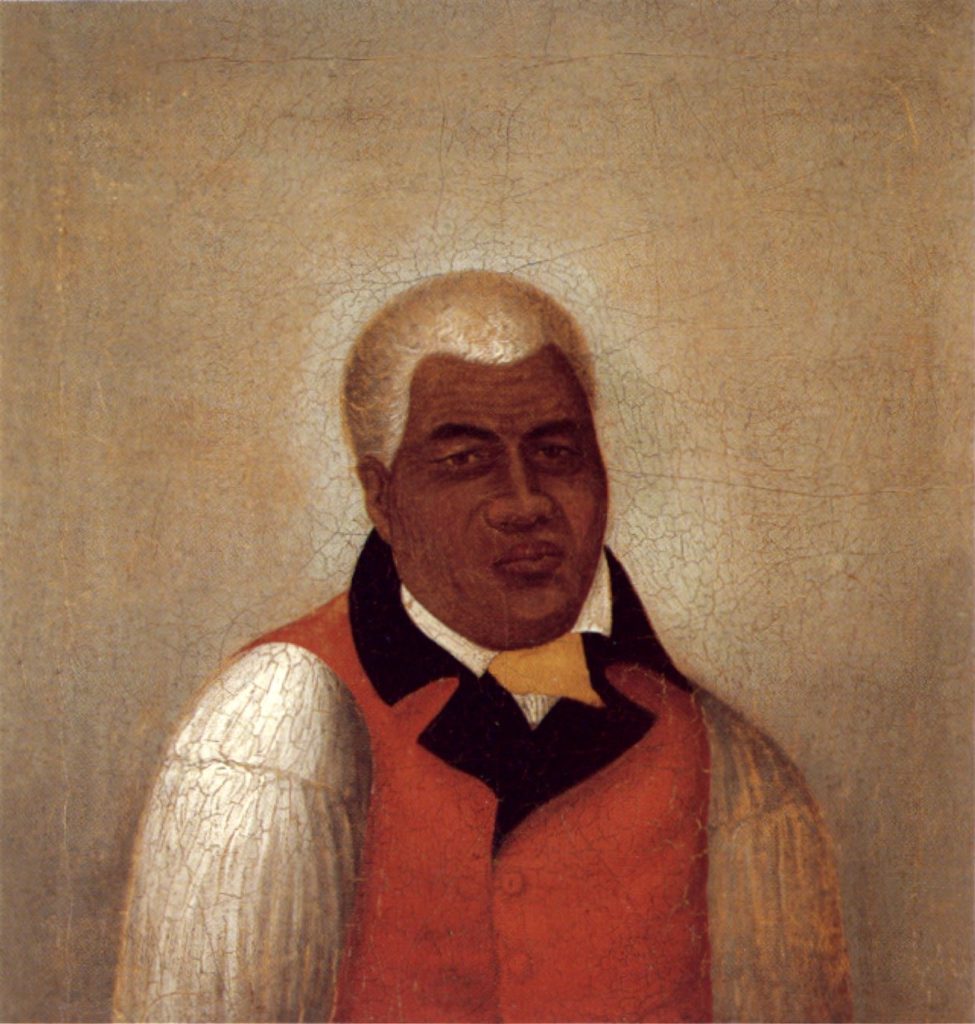At the time of ‘contact’ (Captain Cook’s arrival (1778,)) the Hawaiian Islands were divided into four kingdoms:
(1) the island of Hawaiʻi under the rule of Kalaniʻōpuʻu, who also had possession of the Hāna district of east Maui;
(2) Maui (except the Hāna district,) Molokai, Lanai and Kahoʻolawe, ruled by Kahekili;
(3) Oʻahu, under the rule of Kahahana; and
(4) Kauai and Niʻihau, Kamakahelei was ruler.
On the Big Island, one of Kalaniʻōpuʻu’s wives was Kānekapōlei (Kāne in the circle of beloved ones (ksbe.)) She is reported to be the daughter of Kauakahiakua of the Maui royal family and his wife Umiaemoku; some suggest she is said to have been of the Kaʻū family of chiefs.
According to Hawaiian historian Samuel Kamakau, her father Kauakahiakua owned the sea cucumber (loli) ovens of the district of Kaupo on the island of Maui.
Kalaniʻōpuʻu and Kānekapōlei had two sons, Keōua Kuʻahuʻula and Keōua Peʻeale.
In addition to instruction in all Hawaiian knowledge, not merely in fishing, agriculture, warfare, history and so forth, young chiefs were instructed in sex life.
The latter instruction was imparted by some older woman in the family or attached to it, when the pupil had reached a suitable age (puberty.) Some suggest Kānekapōlei was the one to instruct Kamehameha, and Pauli Kaʻōleiokū was the result of that and known as ‘keiki makahiapo’ (first-born child) of Kamehameha. (Stokes)
During Captain Cookʻs visit to Hawaiʻi on his third voyage of exploration in 1779, then-Lieutenant King (later Captain) mentioned Kalaniʻōpuʻu’s favorite wife Kānekapōlei. He and his men spelled her name many different ways including “Kanee-Kabareea,” “Kanee-cappo-rei,” “Kanee Kaberaia,” “Kainee Kabareea,” “Kahna-Kubbarah.”
“During the following night, the cutter belonging to the Discovery was stolen, so that their depredations seemed confined to what belonged to that ship.”
“This irritated captain Cook, and he gave orders to stop all the canoes that should attempt to leave the bay, intending to seize and destroy them, if he could not recover the cutter by fair means.” (Captain King’s Journal)
Ashore, “Captain Cook’s orders to Mr. King were, to endeavour to quiet the minds of the natives on the side of the bay where he was going, by assuring them that they should not be hurt; to keep his people together; and to be upon his guard.”
“The captain proceeded, with the lieutenant and nine marines, to the village where the king resided. He found him calm and unruffled, to all appearance ignorant of the theft committed on the cutter.” (Captain King’s Journal)
“He (Kalaniʻōpuʻu) readily accepted of an invitation to spend the day on board the Resolution, and accompanied the captain to the beach. His two sons (Keōua Kuʻahuʻula and Kaʻōleiokū) were already in the pinnace (a tender boat,) and the rest of the party were advanced near the water-side …”
“… when an elderly woman, called Kanee-Kabareea (Kānekapōlei,) the mother of the boys, and one of the king’s favourite wives, came after him, and, with many tears and entreaties, besought him not to go on board …”
“… at the same time two chiefs, who came along with her, laying hold of the king, forced him to sit down, insisting that he should go no farther.” (Captain King’s Journal)
“The natives now collected in vast numbers along the shore, and began to throng round captain Cook and their king …”
“… upon which the lieutenant of marines, by the permission of his captain, drew the men up along the rocks, close to the water’s edge, in a line, at the distance of about thirty yards from the place where the king was sitting.”
“At length the captain gave up all thoughts of prevailing upon Terreeoboo (Kalaniʻōpuʻu) to accompany him, observing to Mr. Phillips, that it would be impossible to compel him to go on board, without the risk of killing a great number of the inhabitants.” (Captain King’s Journal)
Shortly after, “Captain Cook, the last time he was seen distinctly, was standing at the water’s edge … he was desirous of preventing any farther bloodshed …”
“… whilst he faced the natives, none of them had offered him any violence, but having turned about to give his orders to those in the boats, he was stabbed in the back”. Cook was killed. (Captain King’s Journal)
Kalaniʻōpuʻu died in 1782. Before his death, Kalaniʻōpuʻu gave an injunction to Kiwalaʻo (another son) and Kamehameha (his nephew,) and to all the chiefs, thus: “Boys, listen, both of you.”
“The heir to the kingdom of Hawaii nei, comprising the three divisions of land, Kaʻū, Kona and Kohala, shall be the chief Kiwalaʻo. He is the heir to the lands.” (Fornander)
Keōua Kuʻahuʻula and his younger brother Kaʻōleiokū had for many years resisted Kamehameha’s attempts to conquer the whole of Hawaiʻi Island, after the death of Kiwalaʻo in the Battle of Mokuʻōhai (1782.) Keōua escaped the battle to relatives in the Kaʻū district to the South. (Stokes)
Keōua was killed in 1791, when Kamehameha invited him to the Puʻukoholā Heiau in Kohala. Pauli Kaʻōleiokū was spared.
Pauli Kaʻōleiokū married Luahine, they had one child, Princess Konia; Princess Konia married Abner Paki, they had one child, Princess Bernice Pauahi. (Kaʻōleiokū was also the maternal grandfather of Princess Ruth Keʻelikōlani.) (Stokes)
Great granddaughter of Kamehameha I and Kānekapōlei, Princess Bernice Pauahi officially was eligible to the throne by order of Kamehameha III; she was offered the throne by Kamehameha V, but refused it.
In 1850, the princess was married at the Royal School to Mr Charles Reed Bishop of New York, who started the bank of what is now known as First Hawaiian Bank. A small wedding was conducted with only a few attending.
Princess Bernice Pauahi Bishop died childless on October 16, 1884. She foresaw the need to educate her people and in her will she left her large estate of the Kamehameha lands in trust to establish the Kamehameha Schools for children with Hawaiian blood.
The image shows Cook’s death, witnessed by Kānekapōlei and her sons and husband.



























